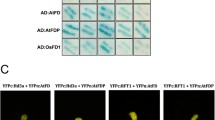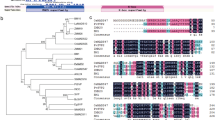Abstract
A previous study revealed that IbEF1 from sweet potato promoted early flowering in transgenic tobacco and acted as a novel regulator involved in flowering time control. Two putative ortholog genes were found in N. tabacum: NtEF1 and NtEF2. Subcellular localization of NtEF1 and NtEF2 with an in vivo targeting approach revealed that NtEF1 and NtEF2 were correctly targeted to the cytosol in protoplasts when expressed as a green fluorescent fusion protein (GFP). NtEF1 and NtEF2 are not thought to act as transcription factors. In this study, the expression of NtEF2 was compared with that of NtEF1 in the apical buds of N. tabacum of various ages. NtEF2 was only detected in open flowers that were 100 days old, whereas NtEF1 was expressed in apical buds of 60-, 70-, 80-, 90- and 100-day-old plants. NtEF1 was expressed in all floral organs, although its level of expression varied in sepals, petals, stamens and carpels. In contrast, NtEF2 mRNA expression was only detected in the sepals. Transgenic tobacco plants overexpressing NtEF1 and NtEF2 were generated to elucidate the physiological function of NtEF1 and NtEF2. The 35S::NtEF1 and 35S::NtEF2 transgenic lines showed early-flowering phenotypes. Moreover, the constitutive expression of NtEF1 and NtEF2 occasionally engendered an abnormal morphological alteration of anthers. It is assumed that there are only a few differential flowering regulations occurring in tobacco compared to Arabidopsis, indicating that NtEF1 and NtEF2 interfere with the flowering time and floral development.










Similar content being viewed by others
Abbreviations
- AP1:
-
APETALA1
- FUL:
-
FRUITFULL
- LFY:
-
LEAFY
- FT:
-
FLOWERING LOCUS T
- AGL20:
-
AGAMOUS-LIKE20
- SOC1:
-
SUPPRESSOR OF OVEREXPRESSION OF CONSTANS1
- SEP:
-
SEPALLATA
- CaMV35S:
-
Cauliflower Mosaic Virus 35S
- CTAB:
-
Cetyl trimethylammonium
- RACE:
-
Rapid amplification of cDNA ends
- PCR:
-
Polymerase chain reaction
- ORF:
-
Open reading frame
- NAA:
-
1-Naphthaleneacetic acid
- BAP:
-
Benzylaminopurine
- HPT:
-
Hygromycin B phosphotransferase
- GFP:
-
Green fluorescent protein
- sGFP:
-
Synthetic green fluorescent protein
- smGFP:
-
Soluble-modified green fluorescent protein
- SAM:
-
Shoot apical meristem
- IM:
-
Inflorescence meristem
- SPLs:
-
SQUAMOSA PROMOTER BINDING LIKEs
References
Abe M, Kobayashi Y, Yamamoto S, Daimon Y, Yamaguchi A, Ikeda Y, Ichinoki H, Notaguchi M, Goto K, Araki T (2005) FD, a bZIP protein mediating signals from the floral pathway integrator FT at the shoot apex. Science 309:1052–1056
Adam H, Ouellet F, Kane NA, Agharbaoui Z, Major G, Tominaga Y, Sarhan F (2007) Overexpression of TaVRN1 in Arabidopsis promotes early flowering and alters development. Plant Cell Physiol 8:1192–1206
Ahearn KP, Jonhnson HA, Weigel D, Wagner DR (2001) NFL1, a Nicotiana tabacum LEAFY-like gene, controls meristem initiation and floral structure. Plant Cell Physiol 42(10):1130–1139
Ahmad AL, Mat Yasin NH, Derek CJC, Lim JK (2011) Microalgae as a sustainable energy source for biodiesel production: a review. Renew Sust Energy Rev 15:584–593
Al-Ahmad H, Gressel J (2005) Transgene containment using cytokinin-reversible male sterility in constitutive, gibberellic acid-insensitive (Δgai) transgenic tobacco. J Plant Growth Regul 24:19–27
An G (1987) Binary Ti vectors for plant transformation and promoter analysis. Methods Enzymol 153:292–305
Araki T (2001) Transition from vegetative to reproductive phase. Curr Opin Plant Biol 4:63–68
Avinish A, Subramaniam D, Murugesan A (2014) Bio-diesel-A global scenario. Renew Sust Energy Rev 29:517–527
Benlloch R, Berbel A, Serrano-Mislata A, Madueno F (2007) Floral initiation and inflorescence architecture: a comparative view. Ann. Bot. (Lond.) 100:659–676
Blazquez M, Soowal L, Lee I, Weigel D (1997) LEAFY expression and flower initiation in Arabidopsis. Development 124:3835–3844
Borner R, Kampmann G, Chandler J, Gleißner R, Wisman E, Apel K, Melzer S (2000) A MADS domain gene involved in the transition to flowering in Arabidopsis. Plant J 24:591–599
Bowman JL, Alvarez J, Weigel D, Meyerowitz EM, Smyth DR (1993) Control of flower development in Arabidopsis thaliana by APETALA1 and interacting genes. Development 119:721–743
Ferrandiz C, Gu Q, Martienssen R, Yanofsky MF (2000a) Redundant regulation of meristem identity and plant architecture by FRUITFULL, APETALA1 and CAULIFLOWER. Development 127:725–734
Ferrandiz C, Liljegren SJ, Yanofsky MF (2000b) Negative regulation of the SHATTERPROOF genes by FRUITFULL during Arabidopsis fruit development. Science 289:436–438
Fornara F, de Montaigu A, Coupland G (2010) SnapShot: control of flowering in Arabidopsis. Cell 141(550–550):e2
Glover B (2007) Understanding Flowers and Flowering: An integrated Approach, first ed. Oxford University Press, Great Clarendon Street, Oxford OX2 6DP, pp.83-94
Huala E, Sussex I (1992) LEAFY interacts with floral homeotic genes to regulate Arabidopsis floral development. Plant Cell 4:901–913
Huang S, Cerny RE, Qi Y, Bhat D, Aydt CM, Hanson DD, Malloy KP, Ness LA (2003) Transgenic studies on the invlovement of cytokinin and gibberellin in male development. Plant Physiol 131:1270–1282
Jack T (2001) Plant development going MADS. Plant Mol Biol 46:515–520
Jang S, An K, Lee S, An G (2002) Characterization of tobacco MADS-box genes involved in floral initiation. Plant Cell Physiol 42:230–238
Kang SG, Jin JB, Piao HL, Pih KT, Jang HJ, Lim JH, Hwang I (1998) Molecular cloning of an Arabidopsis cDNA encoding a dynamin-like protein that is localized to plastids. Plant Mol Biol 38:437–447
Karnovsky MJ (1965) A formaldehyde-glutaraldehyde fixative of high osmolarity for use in electron microscopy. J Cell Biol 27:137A
Kelly A, Zagotta MT, White RA, Chang C, Meeks-Wagner DR (1995) NFL, the tobacco homolog of Floricaula and Leafy, is transcriptionally expressed in both vegetative and floral meristems. Plant Cell 2:1201–1224
Kim KW (2008) Visualization of micromorphology of leaf epicuticular waxes of the rubber tree Ficus elastica by electron microscopy. Micron 39:976–984
Kim SH, Hamada T (2005) Rapid and reliable method of extracting DNA and RNA from sweetpotato, Ipomoea batatas (L). Lam Biotech Lett 27:1841–1845
Kim SH, Song WK, Kim YH, Kwon SY, Lee HS, Lee IC, Kwak SS (2009) Characterization of full-length enriched expressed sequence tags of dehydration-treated white fibrous roots of sweet potato. BMB reports 42(5):271–276
Kim JS, Seo SG, Jun BK, Lee Y, Jeon SB, Choe J, Kim JB, Kim ST, Kim SH (2011) An IbEF1 from sweet potato promotes flowering in transgenic tobacco. Gens Genom 33:335–341
Koo SC, Bracko O, Park MS, Schwab R, Chun HJ, Park KM, Seo JS, Grbic V, Balasubramanian S, Schmid M, Godard F, Yun DJ, Lee SY, Cho MJ, Weigel D, Kim MC (2010) Control of lateral organ development and flowering time by the Arabidopsis thaliana MADS-box Gene AGAMOUS-LIKE6. Plant J 62:807–816
Lee JH, Kim SH, Jung YH, Kim JA, Lee MO, Choi PG, Choi W, Kim KN, Jwa NS (2005) Molecular cloning and functional analysis of rice (Oryza sativa L.) OsNDR1 on defense signaling pathway. Plant Pathol J 21:149–157
Litt A, Irish VF (2003) Duplication and diversification in the APETALA1/FRUITFULL floral homeotic gene lineage: implications for the evolution of floral development. Genetics 165:821–833
Mandel MA, Yanofsky MF (1995) A gene triggering flower formation in Arabidopsis. Nature 377:522–524
Mandel MA, Gustafson-Brown C, Savidge B, Yanofsky M (1992) Molecular characterization of the Arabidopsis floral homeotic gene APETALA1. Nature 360:273–277
Mandel T, Fleming AJ, Kra¨henbu¨hl R, Kuhlemeier C (1995) Definition of constitutive gene expression in plants: the translation initiation factor 4A gene as a model. Plant Mol Biol 29:995–1004
Michaels SD, Ditta G, Gustafson-Brwon C, Pelaz S, Yanofsky M, Amasino R (2003) AGL24 acts as a promoter of flowering in Arabidopsis and is positively regulated by vernalization. Plant J 33:867–874
Mouradov A, Cremer F, Coupland G (2002) Control of flowering time: interacting pathways as a basis for diversity. Plant Cell 14(Suppl. S):S111–S130
Reinheimer R, Kellogg E (2009) Evolution of AGL6-like MADS box genes in grasses (Poaceae): ovule expression is ancient and palea expression is new. Plant Cell 21:2591–2605
Sablowsky R (2007) Flowering and determinacy in Arabidopsis. J Exp Bot 58(5):899–907
Sambrook J, Russell DW (2001) Molecular cloning: A laboratory manual, third ed. Cold Spring Harbor Press, Cold Spring Harbor, New York, pp. 6.39-6.46
Schultz EA, Haughn GW (1991) LEAFY, a homeotic gene that regulates inflorescence development in Arabidopsis. Plant Cell 3:771–781
Schultz EA, Haughn GW (1993) Genetic analysis of the floral initiation process (FLIP) in Arabidopsis. Development 119:745–765
Simson GG, Dean C (2002) Arabidopsis, the Rosetta Stone of Flowering Time? Science 296:285–289
Smykal P, Gennen J, Bodt SD, Ranganath V, Melzer S (2007) Flowering of strict photoperiodic Nicotiana varieties in non-induction conditions by transgenic approaches. Plant Mol Biol 65:233–242
Srikanth A, Schmid M (2011) Regulation of flowering time: all roads lead to Rome. Cell Mol Life Sci 68:2013–2037
Teper-Bamnolker P, Samach A (2005) The flowering integrator FT regulates SEPALLATA3 and FRUITFULL accumulation in Arabidopsis leaves. Plant Cell 17:2661–2675
Wagner D, Sablowski RW, Meyerowitz EM (1999) Transcriptional activation of APETALA1 by LEAFY. Science 285:582–584
Weigel D, Meyerowitz EM (1994) The ABCs of floral homeotic genes. Cell 78:203–209
Weigel D, Nilsson O (1995) A developmental switch sufficient for flower initiation in diverse plants. Nature 377:495–500
Weigel D, Alvarez J, Smyth DR, Yanofsky MF, Meyerowitz EM (1992) LEAFY controls floral meristem identity in Arabidopsis. Cell 69:843–859
William DA, Su Y, Smith MR, Lu M, Baldwin DA, Wagner D (2004) Genomic identification of direct target genes of LEAFY. Proc Natl Acad Sci USA 101:1775–1780
Yamaguchi A, Wu MF, Yang L, Wu G, Poethig RS, Wagner D (2009) The microRNA-regulated SBP-Box transcription factor SPL3 is a direct upstream activator of LEAFY, FRUITFULL, and APETALA1. Dev Cell 17:268–278
Yu H, Ito T, Wellmer F, Meyerowitz EM (2004) Repression of AGAMOUS-LIKE 24 is a crucial step in promoting flower development. Nat Genet 36:157
Acknowledgments
This work was supported by Korea Institute of Planning and Evaluation for Technology (IPET) funded by Ministry for Food, Agriculture, Forestry and Fisheries (311048-05).
Author information
Authors and Affiliations
Corresponding author
Additional information
J. M. Shin and S.-G. Seo are the first authors and contributed equally to this work.
Rights and permissions
About this article
Cite this article
Shin, J.M., Seo, SG., Kim, JS. et al. Ectopic expression of NtEF1 and NtEF2 promotes flowering and alters floral organ identity in Nicotiana tabacum . Plant Biotechnol Rep 9, 11–26 (2015). https://doi.org/10.1007/s11816-014-0336-1
Received:
Accepted:
Published:
Issue Date:
DOI: https://doi.org/10.1007/s11816-014-0336-1




